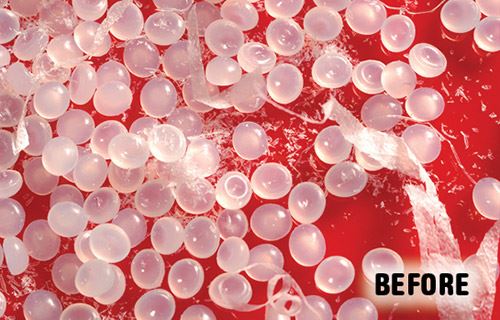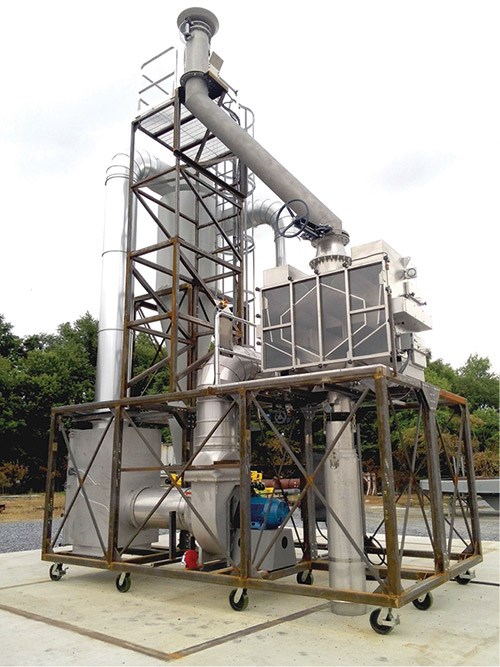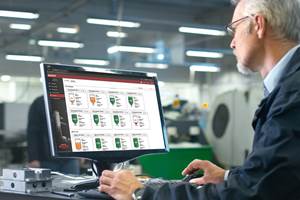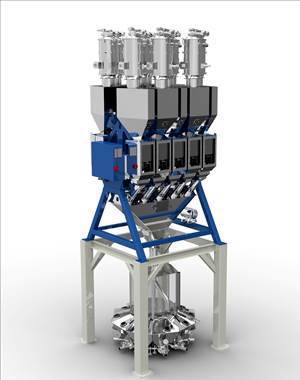Mobile DeDuster Solves Pellet-Quality Problem
Materials Handling
Pelletron system eliminated streamers were gone and cut the dust level down to a range of 30 to 50 ppm.
A supplier of polypropylene recently solved problems of dust and streamers accumulating in its silos with a Mobile DeDedusting System furnished by Pelletron Corp., Lancaster, Pa. The PP supplier, whose name was not divulged, had been extruding and blending PP, then transferring the material over a distance of about 850 ft to a silo farm for loading and bagging at the rate of 130,000 lb/hr.
The firm’s dilute-phase conveying system transferred the resin using a 12-in. conveying line with 10 long-radius elbows. Before final transfer to the storage silos, the material was being cleaned with an elutriator. The elutriator removed short streamers, and the remaining dust content (below 500 microns) was in the range of 80 to 100 ppm.
After the elutriator, the resin was distributed to the storage silos using a 300-ft-long, 115-ft-high, dense-phase conveying system. The dense-phase system created more very fine dust.
In order to determine the dust and streamer content at the silo outlet, Pelletron analyzed 50-lb material samples from the silos at various fill levels in its test lab. The sample from the silo at 100% full had dust levels in the range of 100 to 200 ppm, and few streamers. The sample at 50% full contained dust levels in the range of 200 to 300 ppm—and more streamers. The sample taken from the silo with 10-20% material remaining showed very high dust content, up to 1000 ppm, and many streamers. This was no surprise, because the dust typically accumulates on silo walls and becomes more concentrated as silos empty.
Pelletron cleaned all three samples in the test lab with a DeDuster. All streamers were removed from all three samples and the dust level was reduced to <50 ppm, measured in accordance with the ASTM D-7486-08 Wet Test Analysis.
Based on these tests, Pelletron recommended installing a mobile XP-540 DeDuster to clean 110,000 lb/hr for the truck loading system, and a second mobile DeDuster for the bagging station. The customer proceeded with the recommended implementation in two phases with truck loading taking priority over the bagging station.
Pelletron then proposed a closed-loop system with a washdown DeDuster for easy cleaning of a variety of PP grades. With this system, the electromagnetic flux field generated by coils at the DeDuster inlet reduces the electrostatic charge at the material surface, allowing easy removal of the micro-fine dust generated by the dense-phase system. The cleaning air passes over the unique slot-and-hole pattern of the wash deck and through the venturi zone to remove dust and streamers at what Pelletron says is the highest level of efficiency in the industry. The air flow in the venturi zone is regulated using a bypass air regulator, and a portion of the cleaning air is blown off through a bleed-air valve at the back of the DeDuster to generate the necessary negative pressure at the DeDuster outlet.
Finally, cleaning air flow is provided by a high-performance wash/exhaust-air fan. Contaminants are continuously separated by a high-efficiency cyclone with an inline filter for fine-particle filtration. After passing the inline filter, the cleaned air is returned to the DeDuster. The air volume and pressure of the fan are regulated by the wash-air damper or a variable-frequency drive.
The separated dust and streamers are dropped into a dust drum under the cyclone. A sealed slide gate is installed at the dust outlet of the cyclone to simplify changing the dust drum while the system is in operation.
After installation and testing of the Pelletron sytems, samples were taken at the outlet of the DeDuster and analyzed in the Pelletron test lab. All streamers were gone and the dust level was down to a range of 30 to 50 ppm.
Related Content
Deflection Elbows Eliminate Streamers for Large Film Processor
New elbows eliminate troublesome streamers to increase productivity at leading blown film processor.
Read MoreACS Group Adds Regional Sales Manager
Richard Gutierrez named Southwest regional sales manager.
Read MoreSingle View of Bin & Silo Material Levels in Multiple Locations
Got a bin in Buffalo and a silo in San José? BinMaster’s latest addition to its cloud inventory software lets you see all your resin inventory anywhere in one view.
Read MoreAutomated Resin Management and Blending System for Tight Spaces
NPE2024: Designed for new and existing operations with up to 10 machines and limited available space.
Read MoreRead Next
See Recyclers Close the Loop on Trade Show Production Scrap at NPE2024
A collaboration between show organizer PLASTICS, recycler CPR and size reduction experts WEIMA and Conair recovered and recycled all production scrap at NPE2024.
Read MorePeople 4.0 – How to Get Buy-In from Your Staff for Industry 4.0 Systems
Implementing a production monitoring system as the foundation of a ‘smart factory’ is about integrating people with new technology as much as it is about integrating machines and computers. Here are tips from a company that has gone through the process.
Read More























